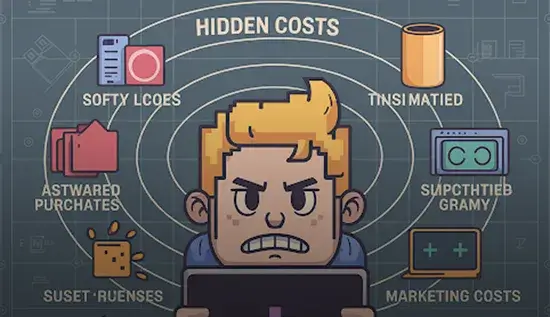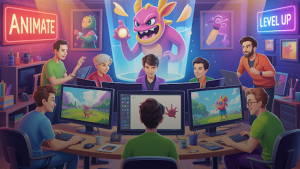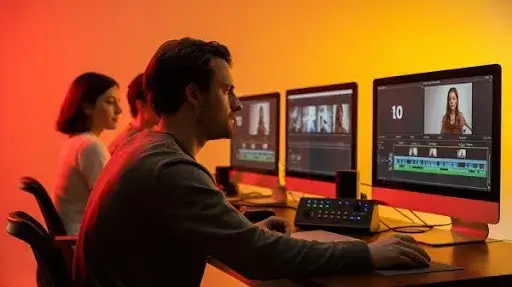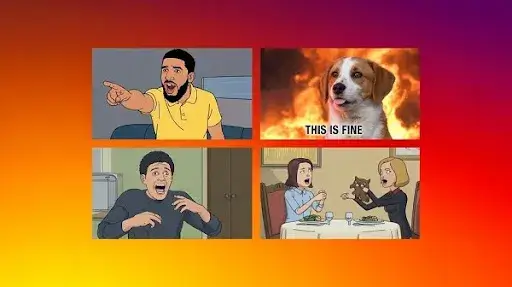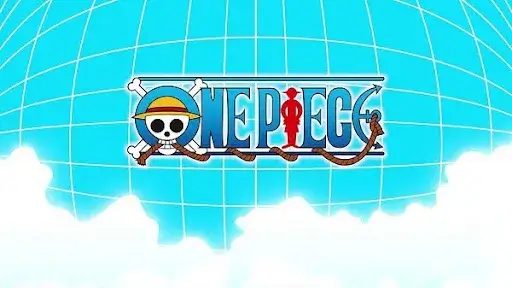The processes of animating for an indie video game can be fulfilling, but if done incorrectly, can also prove to be grueling, costly, and time-consuming. Many indie developers try to complete all the animations independently to reduce cost, only to later discover the numerous hidden expenses associated with do-it-yourself animation.
Considering the technical blunders as well as exhaustion, the actual cost is more than just money; it is also quality, timeline, and creative freedom.
This article will outline the risks associated with do-it-yourself animation, the best times to outsource animation, and how to choose the right studio to help you enhance your game’s cutscenes with 2D or 3D video animation.
Why Do Indie Developers Choose DIY Animation?
This question often follows the realization that cinematic cutscenes are essential to storytelling—a point discussed in our first article, Why Your Indie Game Deserves Cinematic Cutscenes (Even on a Budget). While the benefits of cutscenes are clear, the challenge for many indie developers becomes whether to create them in-house or outsource.
For many indie developers, animation is a passion project. Doing it yourself seems like a good way to save money, control quality, and keep your project fully in-house.
DIY appeals because:
- You already have tools like Unity, Blender, or iClone.
- You want full creative control over visuals.
- You think outsourcing might be too expensive.
But this well-meaning approach can create more problems than it solves.
The True Hidden Costs of DIY Animation
1. Time Drain
As with any form of artwork, animation, and especially cutscene animation, requires extensive planning through rigging, keyframing, syncing, rendering, and most importantly, time. This results in small teams or solo developers experiencing burnout and dreaded delayed releases.
2. Inconsistent Quality
Without professional experience, animation quality may not match the rest of your game. This results in immersion-breaking scenes that feel amateurish.
3. Technical Errors
DIY cutscenes often face bugs: broken rigs, camera glitches, lip-syncing issues, and playback lag in engines like Unity or Unreal. Fixing them eats even more time.
4. Missed Opportunities
You could be spending your limited time on story, gameplay, or marketing—things that directly affect the success of your game.
Not sure if cutscenes are worth it at all? Start with our guide: Why Your Indie Game Deserves Cinematic Cutscenes (Even on a Budget)
When to Outsource Game Cutscene Animation
Outsourcing makes sense when:
- You’ve already built your characters and just need animation.
- Your first scene is done, but the quality needs leveling up.
- You need marketing trailers or intro cutscenes.
- You’re falling behind deadlines.
Outsourcing to professionals ensures consistency, storytelling polish, and integration into your existing pipeline—whether using Unity Timeline, iClone, or another engine.
We recommend working with trusted experts in game cutscene animation services.
The Benefits of Outsourcing to a Studio
- Efficiency: Dedicated animators complete projects faster.
- Experience: Studios specialize in camera work, lip-sync, lighting, and engine-ready delivery.
- Visual Consistency: Outsourcing ensures that every cutscene matches your game’s tone and art style.
- Access to 2D and 3D video animation: Studios like Prolific Studio provide both, helping you create trailers, intros, or in-game sequences.
How Much Does It Cost to Outsource?
| Scene Type | Duration | Cost Estimate |
| Simple Dialogue Cut | 30-60 sec | $600 – $1,200 |
| Action/Combat Scene | 1-2 mins | $1,500 – $4,000 |
| Full Cinematic Scene | 3-5 mins | $5,000 – $10,000+ |
Factors include animation style (2D or 3D), number of characters, lip-syncing, camera dynamics, and revision cycles.
How to Work With an Animation Studio
Here’s how most studios (like Prolific Studio) work:
- Discovery Call – You share your goals, assets, and timeline.
- Proposal – You receive a cost estimate, deliverables, and milestones.
- Asset Review – You send over characters, voiceovers, or storyboards.
- Animation Begins – You review scenes at various stages and provide feedback.
- Final Delivery – You receive Unity-ready (or engine-ready) files.
Do You Need 2D or 3D Video Animation?
Choosing between 2D and 3D video animation depends on your game style, storytelling goals, and platform. This decision also ties into how your animations will be implemented into your engine—something we cover in-depth in How to Seamlessly Integrate Animated Cutscenes into Unity.
If your cutscenes are part of gameplay, 3D animation in Unity or Unreal makes sense. But for trailers, game intros, and lore explainers, 2D video animation may be more cost-effective and stylistically distinct.
Studios offering 2D and 3D video animation services can help you decide based on your budget and goals.
Want help building a cutscene into your engine? Read How to Integrate Animated Cutscenes into Unity Seamlessly.
Frequently Asked Questions
What are the risks of DIY game animation?
DIY game animation often leads to inconsistent quality, technical bugs, and a significant time drain. Without professional expertise, indie developers may end up with scenes that break immersion or fail to align with game pacing and tone.
Is outsourcing cutscene animation expensive?
It depends on the scope, but outsourcing can often be more cost-effective than you think. Many studios work with indie budgets and offer pricing flexibility, especially when reusing your existing assets.
What if I only need help animating a few scenes?
That’s totally fine. Studios like Prolific Studio offer à la carte options, including help with specific scenes, trailers, or promotional animations. This lets you stay in control while getting expert assistance.
Can I mix 2D and 3D animation in my game?
Yes! Many successful indie games combine both styles for variety—2D for UI or intros, and 3D for in-game cinematics. It adds texture and keeps presentation visually engaging.
How do I communicate with an outsourced team?
Most studios use project management tools like Trello, Slack, or ClickUp to keep communication smooth. Expect regular updates, previews, and structured feedback rounds.
Will outsourcing slow down development?
Actually, it speeds it up. That being said, having a partner might take a few days to adjust to, but by handing over animation tasks, you will be able to shift your focus towards the more important aspects of gameplay or pre-release.
What should I prepare before outsourcing?
You should have basic materials like character models, scripts, voiceovers, and visual references. The clearer your brief, the faster the studio can deliver quality work.
Is Unity compatible with outsourced cutscenes?
Absolutely. Studios use Unity Timeline, Cinemachine, and animation rigs that work seamlessly with your project. You get cutscenes that are plug-and-play with your Unity build.
What’s better—2D or 3D cutscenes?
While 2D animation is cheaper and more time-efficient, a good studio will provide the best approach based on budget, style, and deliver cinematic realism through 3D animation.
Where can I find a studio that understands indie game animation?
Start with Prolific Studio’s game cutscene animation services. They specialize in both 2D and 3D animations and cater to indie developers with customized packages.
Final Thoughts
DIY animation is tempting, but it often costs more than it saves in time, quality, and stress. If you want cinematic cutscenes that impress players and elevate your narrative, outsourcing is a smart move.
Prolific Studio is a top-tier provider of 2D and 3D video animation services in the USA, trusted by indie game developers for their expertise, flexibility, and quality.
If you’re ready to delegate the hard part and focus on what matters, check out our game cutscene animation services.

